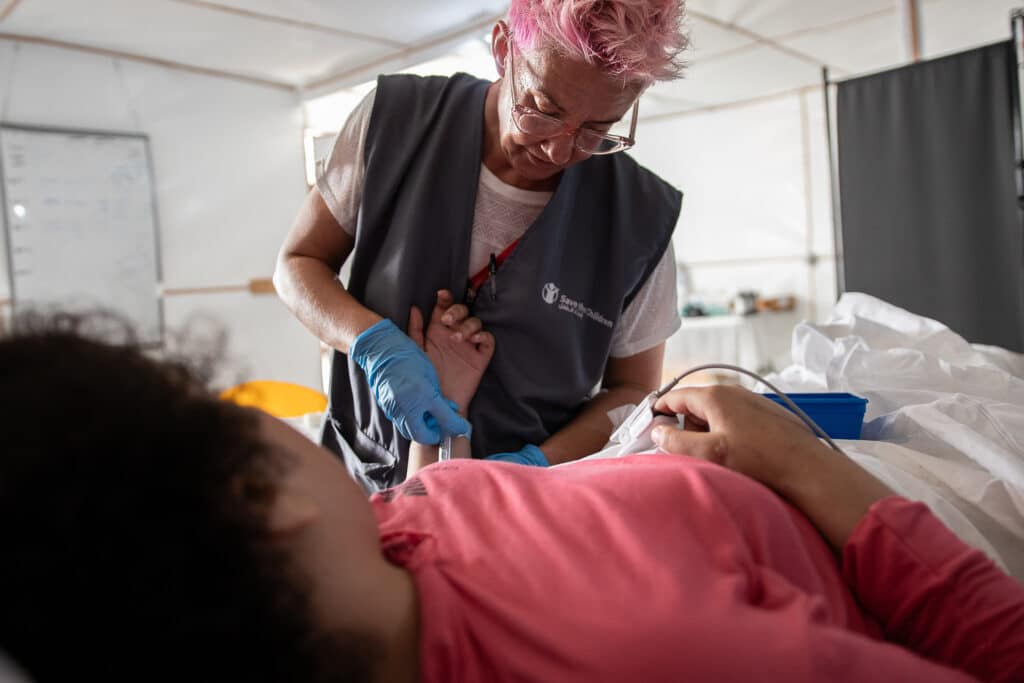When I first arrived in Gaza, I was completely blown away by what I saw. I thought I had been prepared for it by watching the news and looking at photos and so on. But nothing prepares you for what it’s actually like to be in Gaza.
There were decimated buildings all around me and rubble everywhere. Multiple children were crawling over that on their own, hunting through the piles of rubbish, finding things to eat. It’s really difficult to get hold of anything at all in Gaza.
One of the things that we really, really needed was stronger pain relief for children. We had paracetamol and ibuprofen that you might take for a headache, but we were using that to treat the pain of children who’d had their limbs blown off. I think that’s when it really hit. It’s just not fair. It is not fair that we’ve got children with devastating injuries who don’t have access to pain relief.
One of the children that I met while I was there was a 13-year-old girl who was sheltering in her aunt’s home when the house got bombed. She lost several of her brothers and her right leg in that blast. Eventually she got out and she was taken to al-Shifa hospital. While she was there, the hospital was also bombed, so the wounds became infected, and she was moved to the field hospital where I was working. She was in agony; she couldn’t look at her stump or touch it. It was just too distressing for her.

In Gaza, I saw multiple children who’d been injured in bomb blasts. Many of these children had lost one or more limbs. It just feels like your hands are tied when you can’t do what could easily be done at home or in another context.
One story that gave me hope while I was there was the first baby born in the maternity field hospital. A little girl, we’ll call her Lana. She was absolutely gorgeous, and it brought a huge amount of joy to the whole of the field hospital.
She was a great morale booster. I think we knew that the maternity hospital was very much needed because there’s such a young population in Gaza and the multiple pregnant women who need to deliver.
Children are different in the way that they sustain injuries during conflict. So, it’s really important that people who are looking after children are specialists in looking after children.
They need to be able to manage blood loss and tourniquet application, and to be able to do the kind of damage control trauma surgery that is required in that setting.
We drove past shelters where people had made some kind of home out of pieces of wood, maybe pieces of fabric, occasionally a piece of carpet or tarpaulin to just provide some kind of shelter.
There’s no floor – people are living on the dirt or the sand. Children don’t have a bed to sleep in. Most of them don’t have a cover over them. Children don’t have access to a reliable source of nutrition. We saw people eating very basic food in very short supply. Children have not been in education since October. Save the Children are doing a lot to address those needs, but there’s so much more to be done.
The psychological distress that I witnessed among children and young people is like nothing I’d ever seen before. They need a huge amount of mental health support. These children have had their lives completely changed. Life today is unrecognisable from what it was before. Every day you hear bombs falling and machinegun fire. Often you can feel it because the ground shakes, particularly in the evening and overnight. Bombs were coming over and those moments were terrifying.
I’ve worked in several other humanitarian contexts, and I’ve also deployed to Ukraine, which was another conflict zone. But Gaza was like nothing I’ve ever seen before, both in terms of healthcare needs and in terms of the whole humanitarian context. Seeing homes and landscapes completely devastated and just the absolute level of human suffering and need was absolutely mind blowing.
It’s very easy to be overwhelmed by the numbers when we watch the news or read about what’s happening in Gaza. Remember that each one of those numbers is one person, a child who has been forever changed by what’s happened. Then multiply that one child by thousands. That’s the work that needs to be done.


